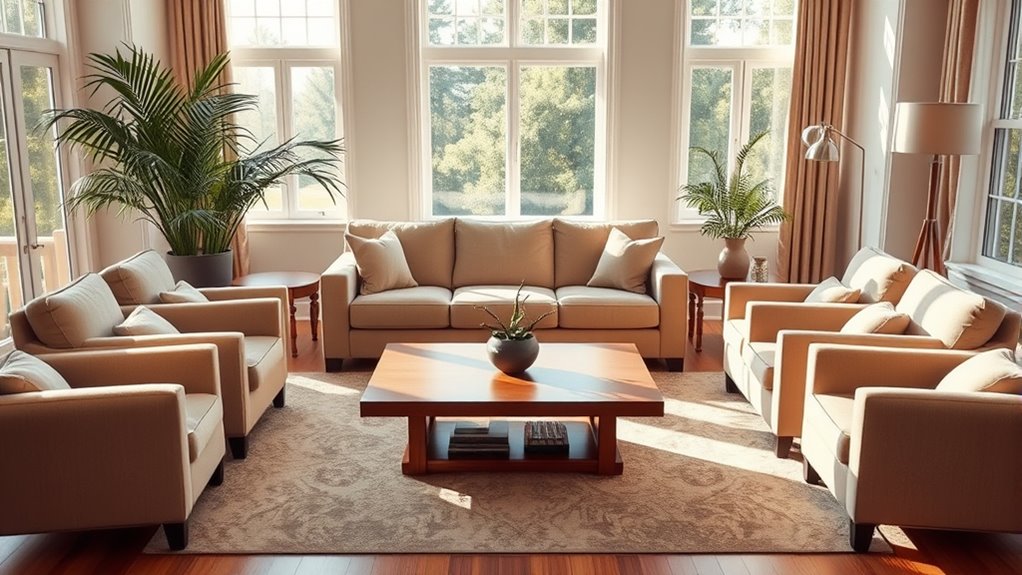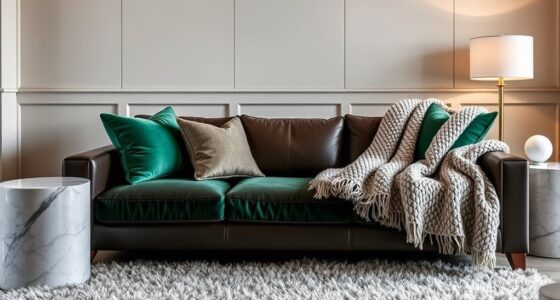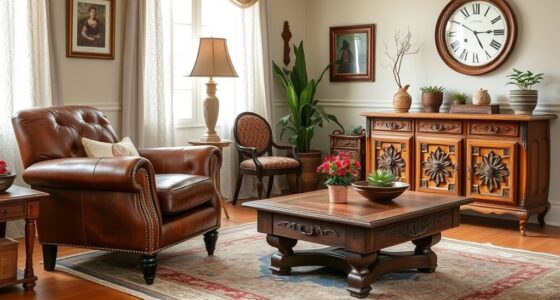The key to creating a balanced room is using symmetry and thoughtful furniture placement. You want to arrange furniture so it feels harmonious, guiding the eye smoothly around the space. Incorporate a focal point like a fireplace or artwork to anchor the room and guarantee balance through proportional sizes and contrasting textures and colors. Pay attention to flow, grouping items, and refining the layout. Stick with these principles, and you’ll discover how to make your space truly feel cohesive and inviting.
Key Takeaways
- Use symmetry to create visual balance and harmony in furniture placement.
- Anchor the room with a strong focal point and arrange furniture to emphasize it.
- Ensure proportional furniture sizes and maintain clear pathways for natural flow.
- Incorporate contrasting textures and harmonious colors to add depth and interest.
- Regularly refine and adjust furniture placement to improve symmetry and overall balance.
The Power of Symmetry in Room Design
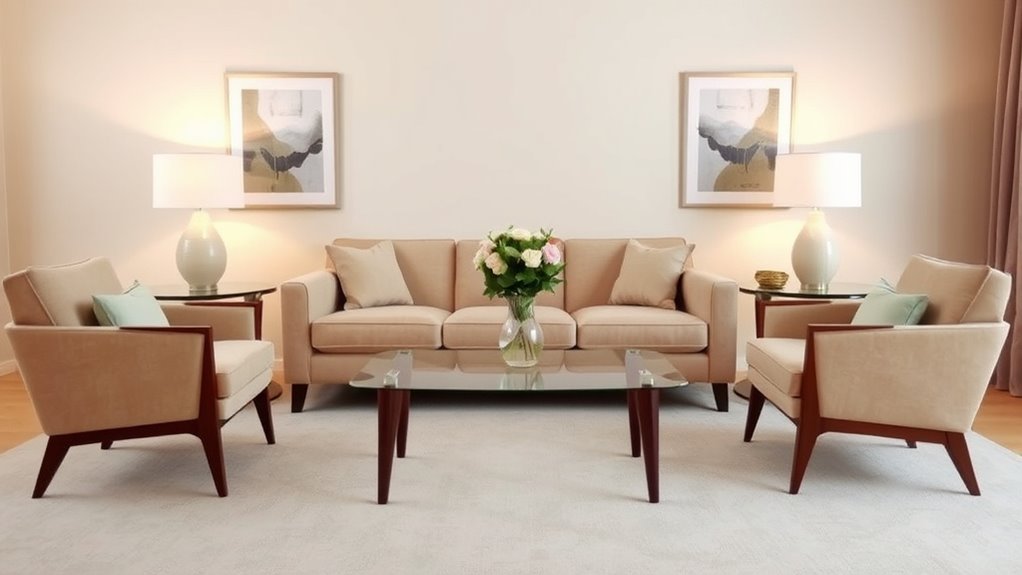
Symmetry plays an essential role in creating a balanced and harmonious room design. When you arrange furniture symmetrically, you establish a sense of order that naturally feels pleasing to the eye. Think about pairing sofas with matching side tables or placing identical chairs on each side of a fireplace. This approach guides your eye smoothly around the space, making it feel cohesive and well-organized. Symmetry also helps you create a calming environment, as humans tend to find mirrored layouts comforting. You don’t need perfect mirror images everywhere—just balance key elements to achieve harmony. Incorporating principles of visual balance can further enhance the overall aesthetic of your room. By emphasizing symmetry, you make your room look intentional and polished, elevating its overall aesthetic effortlessly. Additionally, integrating rustic decor elements can reinforce the cozy, farmhouse feel while maintaining visual harmony.
Anchoring Your Space With a Focal Point
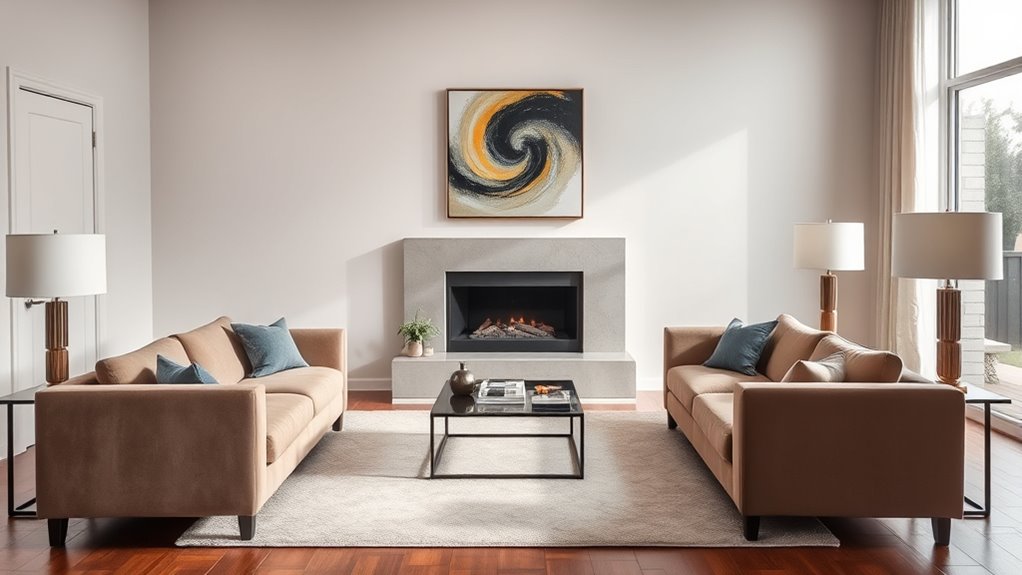
To anchor your space, start by choosing a strong visual focal point, like a fireplace or artwork. Position your furniture to direct attention toward this feature, creating a natural conversation area. This helps your room feel cohesive and inviting from the moment you walk in.
Choose a Visual Anchor
Ever wondered how to instantly make a room feel more organized and inviting? The secret is choosing a visual anchor that draws attention and sets the tone for the space. This could be a striking piece of art, a fireplace, or a statement furniture item like a bold sofa. Your goal is to create a focal point that naturally guides your eye and provides a sense of balance. When you select a strong visual anchor, everything else in the room can be arranged around it, making the space feel cohesive and intentional. Keep in mind that cybersecurity vulnerabilities can threaten the integrity of your digital environment, just as poor furniture placement can disrupt a room’s harmony. Don’t clutter the area around your anchor—keep it clear and prominent. Incorporating rustic elements such as vintage furniture or natural materials can further enhance the charm and authenticity of your farmhouse kitchen. Being mindful of furniture arrangement principles ensures a harmonious flow and maximizes the usability of your space. Understanding how somatic therapy integrates mind and body can help you create a more balanced and calming environment, whether through physical space or emotional well-being. Additionally, exploring creative techniques can unlock new ways to enhance your interior design and personal expression. This simple step anchors your design, making your room feel more polished and inviting effortlessly.
Position for Focus
Once you’ve chosen a strong visual anchor, the next step is to position it thoughtfully within your space. Placement considerably impacts how balanced and inviting your room feels. To create focus, consider these tips:
- Place your focal point near a natural eye line, like eye level with a fireplace or artwork.
- Center larger pieces, such as a sofa or bed, around the focal point to draw attention.
- Avoid clutter around your anchor to maintain clarity and emphasis.
- Use lighting to highlight your focal point, making it stand out even more.
- Incorporate color coordination and proper lighting conditions to enhance the visual impact of your focal point and create a cohesive, balanced environment.
Balancing Sizes and Proportions of Furniture

Balancing the sizes and proportions of furniture is essential for creating a harmonious and functional space. When selecting pieces, consider how each item relates to the room’s overall size. Larger furniture should be proportionate to the room, avoiding overwhelming smaller spaces or appearing tiny in larger ones. Mix different heights and widths to add visual interest without cluttering. For example, pair a substantial sofa with slender side tables or tall bookshelves to create contrast. Keep proportions consistent; a bulky armchair may look out of place next to a delicate coffee table. Additionally, understanding the visual balance of furniture helps guide the arrangement process effectively. Recognizing visual weight enables you to distribute elements evenly across the room, enhancing overall harmony. Incorporating design principles like balance and proportion helps ensure the space feels cohesive. Being aware of spatial relationships assists in achieving a well-organized layout that feels natural and inviting. By thoughtfully balancing furniture sizes, you ensure the room feels cohesive, inviting, and comfortable. This balance guides the eye smoothly across the space, making it feel well-planned and aesthetically pleasing. Furthermore, considering cultural intelligence can help in understanding diverse aesthetic preferences and ensuring the space appeals to a broader range of tastes.
Creating Clear Pathways and Flow
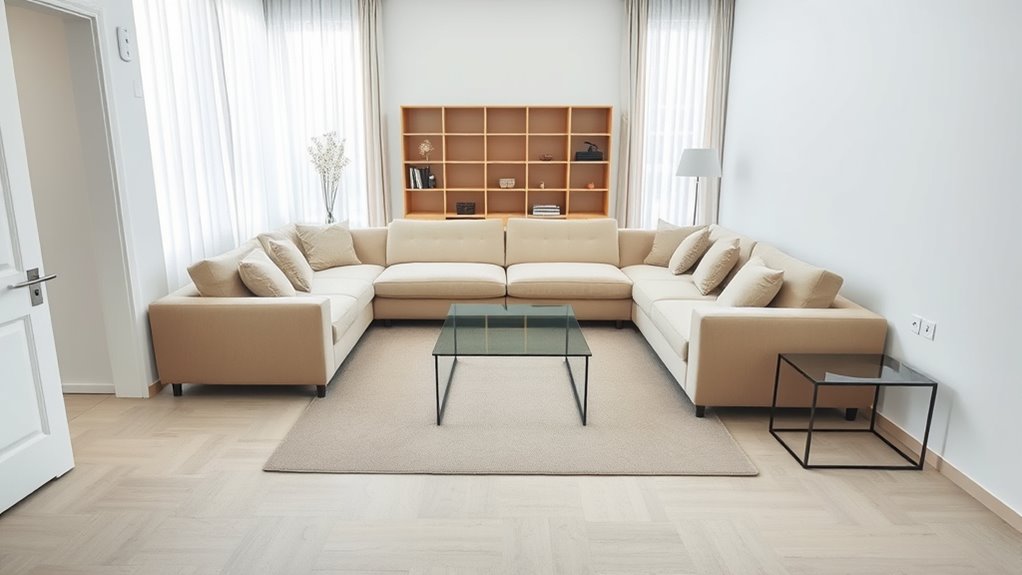
Creating clear pathways and flow is essential for making your space functional and easy to navigate. You want to make sure people can move comfortably without obstacles blocking their way. Think about the main routes through your room and keep them open. Arrange furniture so that pathways are at least 24-30 inches wide, allowing easy movement. Avoid placing large pieces in ways that create dead ends or tight spots. Instead, focus on guiding the eye naturally from one area to another. Use these tips:
- Keep walkways clear of clutter and furniture
- Position seating to face main entry points
- Leave enough space around tables and rugs
- Arrange furniture to create logical zones
Maintaining good home organization also involves regularly assessing your space and adjusting furniture placement to stay functional and inviting. A well-planned flow keeps your room feeling open, inviting, and easy to use. Incorporating Water Parks in nearby areas can also inspire fun and relaxing zones within your home layout. Additionally, considering the signs of spoilage in your decorative items or storage areas can help maintain a fresh and welcoming environment. Regularly inspecting your space for clutter or damage can prevent issues and keep your home feeling orderly and comfortable.
Grouping Items for Visual Cohesion
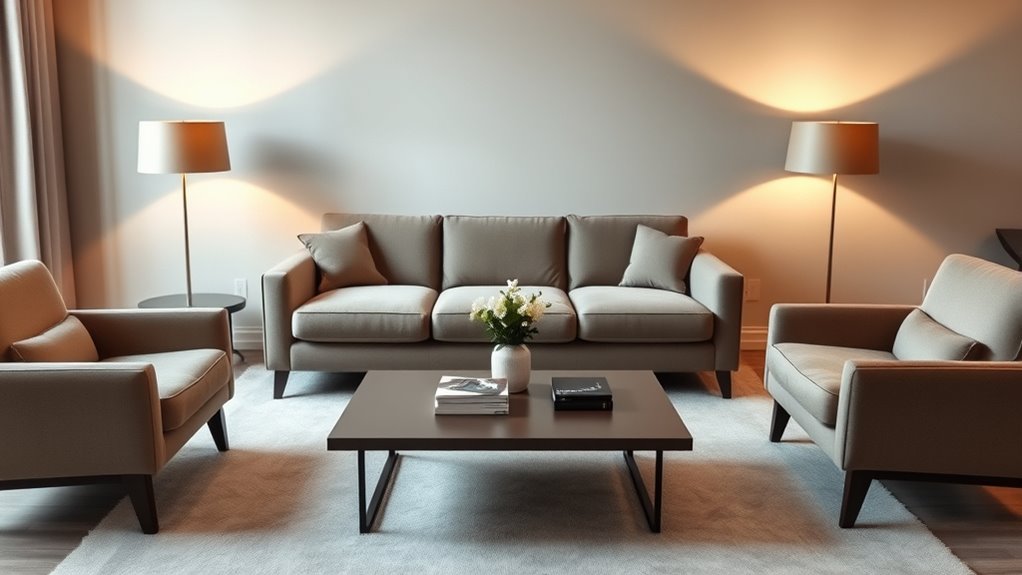
Grouping related items together can instantly enhance your room’s visual coherence, making the space feel more organized and intentional. When you place accessories, lamps, or decorative pieces near each other, it creates focal points that draw the eye smoothly across the room. This technique helps reduce clutter and makes your space look thoughtfully curated. For example, keep books, candles, and small decor on a single coffee table or shelf to create a unified display. Similarly, cluster chairs and side tables in a conversational grouping rather than scattering them randomly. Remember, your goal is to guide the eye naturally through the space, so group items with a common theme or purpose. Using themed costumes or coordinated decor can also add to this visual cohesion, making your room feel more harmonious and inviting. Incorporating furniture arrangement techniques that emphasize balance and symmetry can further enhance the overall aesthetic, and paying attention to space planning ensures every element contributes to a cohesive look.
Using Color and Texture to Enhance Balance

Using contrasting hues and textures can make your furniture arrangement pop while maintaining balance. Incorporating harmonious color schemes ties the space together seamlessly. Experimenting with these elements helps you create a visually appealing and balanced room. Paying attention to recurring angel numbers can also inspire intuitive choices in your decorating process, fostering harmony and positive energy. Additionally, integrating automation technologies can streamline your design process and help visualize different configurations more effectively.
Contrasting Hues and Textures
When you introduce contrasting hues and textures into your furniture arrangement, you immediately add visual interest and depth to a space. Bold color combinations or varied textures draw the eye and create a dynamic environment. To maximize this effect, consider mixing smooth surfaces with rough ones, or vibrant colors with muted tones. This contrast helps balance the room and prevents it from feeling flat. Incorporating colorful flavors, much like unique gelato flavors, can enhance the visual appeal and create a more inviting atmosphere. Additionally, understanding color theory can help you select harmonious contrasts that elevate your decor. Here are some ideas to try: – Pair a plush velvet sofa with sleek metal accents – Use a textured rug with colorful throw pillows – Combine matte painted walls with glossy furniture – Mix wooden furniture with metallic decor These contrasts make your room feel lively and well-balanced, highlighting each element’s unique qualities.
Harmonious Color Schemes
Building on the idea of creating visual interest with contrast, incorporating harmonious color schemes brings a sense of unity and serenity to your space. Choose colors that complement each other naturally, such as soft neutrals paired with gentle pastels or analogous shades on the color wheel. Use textures—like plush fabrics, smooth surfaces, or woven materials—to deepen the sense of harmony. When selecting your palette, consider the mood you want to evoke; cool tones promote calm, while warm shades add coziness. Balance is key: avoid overwhelming the room with too many bold colors, and instead, let subtle variations and consistent textures unify your design. This approach helps your furniture and decor feel cohesive, making your room more inviting and visually balanced.
Adjusting and Refining for Perfection
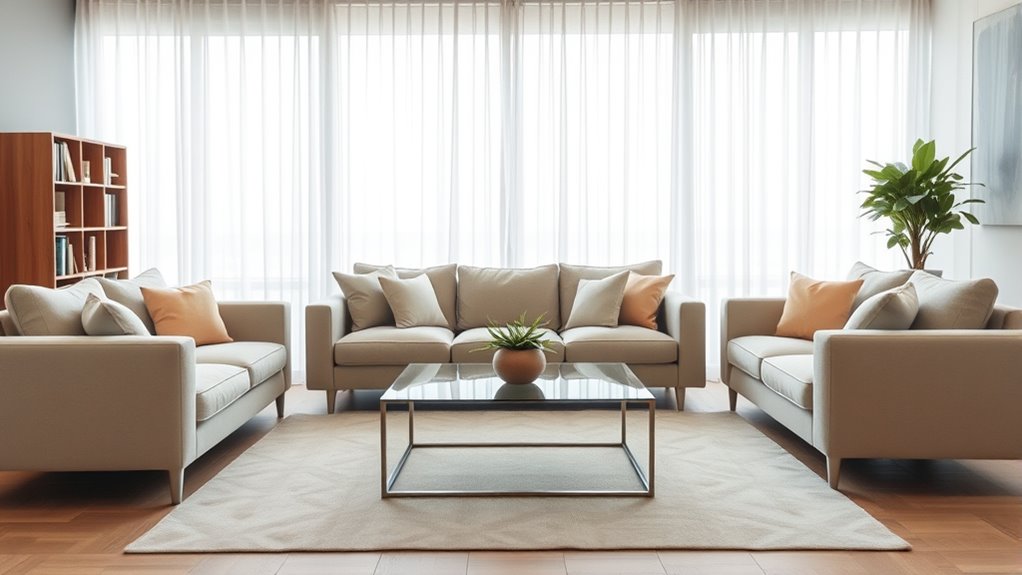
Fine-tuning your furniture arrangement is essential to achieving a balanced and functional space. Once you’ve set up your layout, take time to refine it for optimal comfort and flow. Move pieces slightly to improve symmetry, ensuring pathways remain clear. Pay attention to focal points like a fireplace or view, adjusting furniture so they’re highlighted. Test your setup by sitting in different spots to see if it feels natural and inviting. Make small tweaks until the space feels just right.
Refine your furniture layout for better flow, balance, and inviting comfort through small, thoughtful adjustments.
- Rearrange pieces to improve balance and harmony
- Adjust the height and angle of furniture for better sightlines
- Incorporate accessories or rugs to unify the space
- Remove unnecessary items to reduce clutter
Frequently Asked Questions
How Do I Balance Asymmetrical Room Layouts Effectively?
Balancing asymmetrical room layouts can seem tricky, but you can do it by creating visual weight on both sides. You could place larger furniture pieces or bold decor on one side and balance them with smaller items or accessories on the other. Use rugs, lighting, or artwork to draw the eye evenly across the space. Keep experimenting until the room feels harmonious and inviting.
Can Small Rooms Benefit From Symmetrical Furniture Arrangements?
You might think small rooms can’t handle symmetry, but they actually can benefit from it. Symmetrical furniture arrangements create a sense of order and balance that makes a tiny space feel more open and harmonious. By placing matching pieces opposite each other or centered around a focal point, you draw the eye inward and make the room appear larger. So, yes, symmetry can be a smart choice for small rooms.
What Are Common Mistakes That Disrupt Room Balance?
You might disrupt room balance by overcrowding with furniture, making the space feel cramped. Ignoring focal points or symmetry can also throw off harmony, causing the room to seem chaotic. Placing furniture unevenly or at awkward angles creates visual imbalance. Additionally, neglecting proper scale—using small pieces in a large room or vice versa—can make the space feel awkward. Avoid these mistakes to maintain a visually appealing, balanced room.
How Does Furniture Placement Affect Room Perceived Size?
When you place furniture thoughtfully, it can make your room feel more spacious or cozy. For example, positioning larger pieces against walls opens up central space, making the room seem bigger. Conversely, cluttered or awkward arrangements can shrink the perceived size. You should aim for balanced, open layouts that allow easy movement. Proper furniture placement enhances the room’s perceived size, creating a welcoming atmosphere without sacrificing comfort or style.
Are There Universal Rules for Balancing Modern and Traditional Furniture?
You wonder if there are universal rules for balancing modern and traditional furniture, right? Well, imagine trying to fit a sleek spaceship next to a vintage steam engine—chaotic, isn’t it? The key is blending styles harmoniously by mixing clean lines with ornate details, balancing colors, and maintaining symmetry. Trust your eye, keep proportions in check, and you’ll create a space where both styles coexist beautifully, no matter the rules.
Conclusion
By applying these furniture arrangement secrets, you’ll transform your room into a harmonious haven. Think of your space as a beautifully balanced dance, where every piece moves in harmony. When you focus on symmetry, focal points, and flow, your room will feel like a well-tuned orchestra, inviting comfort and style. With a little tweaking and patience, you’ll create a space that feels just right—like a perfectly crafted symphony of design.
